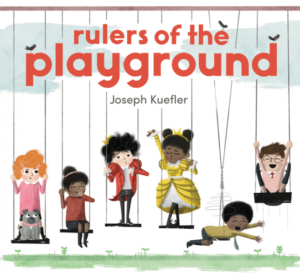Why I Picked It Up:
It was on display at Barnes and Noble and caught my eye. Maybe it was the thick red letters, but then my eye moved from swing to swing studying the kids. Um … the two in the middle … get out! I love the royal clothes and felt it was necessary to read more.
Why I Finished It:
It was ADORABLE! My mind raced the whole way through, is this a reading strategy book? A social studies book? A character education book? The answer to all is – YES! This story is all about conquering and ruling your land. At first, Jonah declares he is the ruler of the playground, but soon a new ruler emerges and splits the land so both can rule. Of course, the issue occurs with unhappy “citizens”, the corruption of power, and battling for supreme control. The drawings and the story are just plain fun.
Who I Would Give It To:
Definitely EVERY elementary teacher. I also think this is a book parents would enjoy reading to their kids. Since I have no shame, I’ll admit I read it a few times, just for fun. So maybe every 40ish-year-old needs one too!
Integration Ideas
Social Studies
My mind first went to using this book in social studies. We have two workshop sessions, Historical Fusions and Beyond the Textbook, that is all about using regular picture books to teach social studies concepts. This book will be added to the session! When my students are learning about colonists, people taking over lands, and setting up government structures, we will read this book aloud!
For the younger students, I would use this story to talk about rules. Why do we have rules? As a class, we would come up with the fact that some rules are for safety and some are for structure. After reading the story, we could talk about the rules on the playground and why they are important. We would also talk about who is responsible for making the rules and following the rules.
With older students, this book could be used to talk about how someone conquers the land. This could be connected to the American Colonists, the first landing on the moon, different worldwide occupations, etc. What is needed to take over land? How would one accomplish such a lofty task? We would also discuss rulers. What makes a strong leader? Can a leader lead without subjects?
Character Analysis
No way around this! I love the kids (the noble leaders, if you will) in this story! (I actually really want to meet them. After reading the author’s info on the back flap of the book jacket, I am convinced this story is of his three children!) Those of us with multiple children can connect this story to how it is also about ruling the house and learning how to adjust to a new sibling!
Before reading the story, I would ask students about the qualities they would like in a friend and the qualities they would like in a leader.
After reading the book, have students discuss the two main characters (Jonah and Lennox). What qualities do they have? Have the students provide evidence from the text to support their ideas. How do the characters change towards the end?
There are quite a few pages similar to this one! I love it! It explains the leader has a personality trait … most of the time. Have students share what would make, in this example, the leader wise. What are some wise moves a leader could make? Then ask if a leader can be wise all the time. What should they do when mistakes are made? What about this playground example? What is Lennox doing that makes her wise and what makes her not so wise?
There is a big change of heart with both Lennox and Jonah in this story. Have students explain the change the characters undergo. Then ask students to make predictions for what will happen when Augustine shows up.
Dialogue and Quotation Marks
This book is full of dialogue. This would be a great mentor text for the Writers’ Workshop. After reading the book, choose one piece of dialogue from the story. Ask students what they notice. It is important that students notice where commas, quotation marks, periods, and capital letters are in dialogue. When they notice and discuss punctuation in sentences grammatically correct they begin to internalize the rules of writing.
Also, spend time with students noticing how dialogue helped build in the characters’ feelings and traits. Have students decide how dialogue helped to move the story.
Have students go into their own writing and add dialogue. The dialogue should reflect the voice of the character and should be punctuated correctly.
Contact us if you’re interested in Historical Fusions or Beyond the Textbook coming to your campus!









Leave a Reply